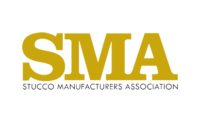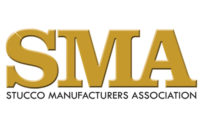The Stucco Manufacturers Association was incorporated in 1957 and has been the voice of the stucco industry since. The SMA publishes technical papers, holds networking events and has various committees that help guide the future of stucco. A lot has changed since 1957, and while the SMA was originally focused on cement stucco finish coats, the SMA now has members that produce scratch and brown coats, one coat stucco, acrylic-based finishes, Venetian plaster and many other products.
The SMA Marketing and Promotion Committee felt a marketing report on stucco as a siding was needed to understand where stucco has been, is currently and its future outlook. This document, called the “2016 Stucco Market Report,” was released and is available as a free download on the SMA’s website.
The 2016 report contains U.S. census data on exterior siding trends in housing dating back to 1971. The report only covers dominant cladding materials in each region and was good for a big picture view. The U.S. census data grouped traditional cement-based stucco with other claddings that simply resembled stucco; including EIFS, direct applied systems and one coat stucco. Data from other reports was also reviewed and included.
The committee is already working on improving and expanding the scope of the report to increase its value to the industry.
Noticing the Trends
The current report exhibits clear trends in consumer preferences and building practices. Some of these reports noted shifts in stucco market share. Some shifts were regional, while others were by building type. This left the authors of these other reports with data, but no explanation as to why these market shifts are happening. The SMA committee felt through their expertise in stucco and industry contacts, it might be possible to determine why certain shifts occurred and what trends might be heading our way.
The committee began a series of research interviews starting this past December. Interviews included architects, developers, suppliers, inspectors and plastering contractors. The range of interviews was throughout the United States and as the information was reviewed, certain patterns became apparent.
One clearly noted item was installed cost. In regions of the country where stucco is very popular, the cost per square foot was substantially lower than in markets where stucco is not popular. While this was not surprising by itself, it did not explain why regions with once good stucco markets were showing signs of dramatic decline. The SMA report attempts to shed light on potential factors for lost market.
While the competition for cladding market share is tough and stucco has taken hits in some markets, there is good news.
The report clearly illustrates that stucco remains a siding of choice. This can be seen as the data shows the more expensive the house, the more likely stucco is used. This is partially due to the fact that homes in many strong stucco markets tend to cost more. For example, the median home price in Kentucky is just less than $150,000 and the median home price in California is more than $410,000. Since California is a strong stucco market for homes, this would result in a data shift to stucco being more popular on higher priced homes. However, past research reports note that stucco is often a preferred cladding for the residential and commercial markets.
A Demand for Stucco
The ironic fact that helps tie this together was the results of the SMA online architect learning program. Monthly reports repeatedly demonstrate that architects taking the classes were from regions where stucco market share is traditionally very low. This means there is interest in stucco and the designers want to learn more about how it could work in the area.
The challenge for our industry is to get stucco installed in their regions for a cost close to competitive sidings and build a reputation of success in that market. The SMA has already begun to implement plans to increase market share for stucco use.
The stucco industry has many new innovations and opportunities, but there are also challenges. Generally, people like the look of stucco, it is just a matter of putting the pieces together with some quality control to give the people what they want; quality stucco for a competitive price.





Report Abusive Comment